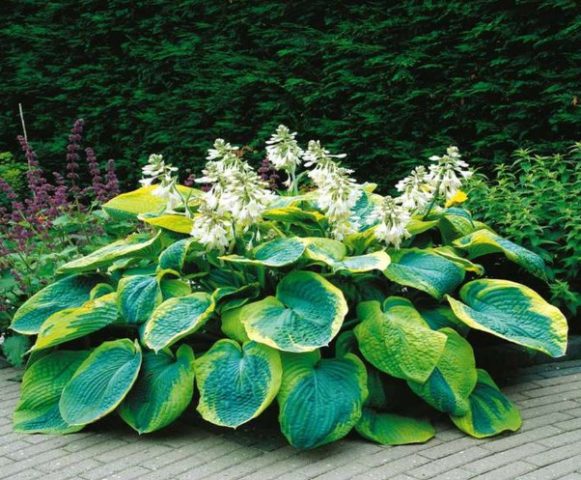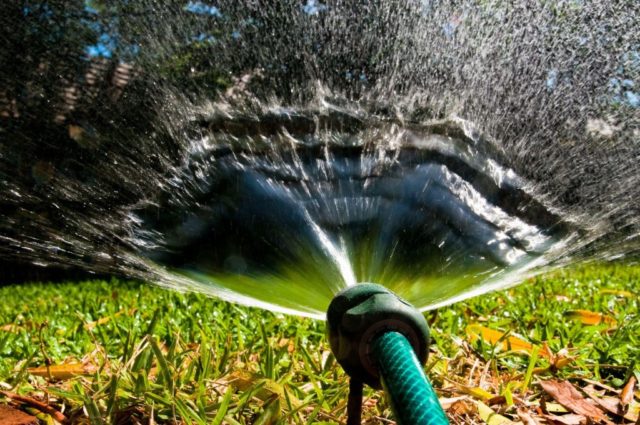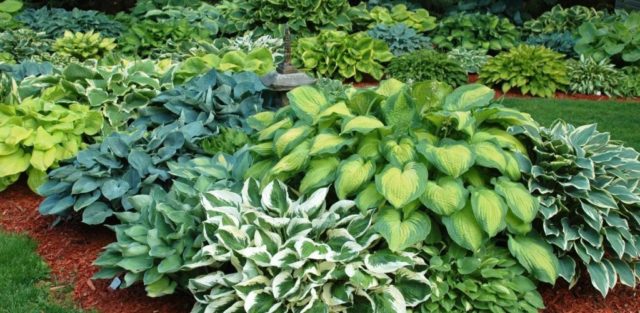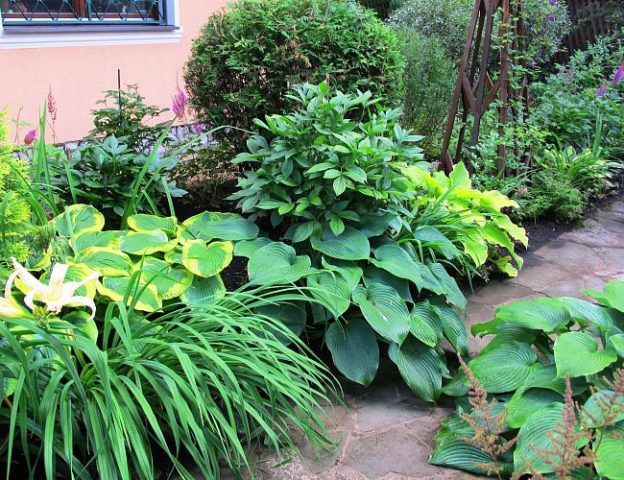Content
Hosta Francis Williams is a lush perennial shrub with bluish green leaves. Exotic culture adorns even the most nondescript corners of the garden, looks great in compositions with flowers, conifers and other types of hosts. Due to its high winter hardiness, the plant is successfully grown in most regions of Russia, including those with unfavorable conditions.
Description of hosts Frances Williams
Francis Williams is an attractive hosta with large oval-shaped leaves (20 cm long, 10 cm wide). The surface is wrinkled, matte. The color is combined: in the center the leaves are green with a shade of blue, along the edges there is a yellow edging. The bush is quite high (up to 80 cm) and at the same time compact (up to 120 cm wide). Shade-tolerant, prefers partial shade from shrubs or trees.
Hosta Francis Williams blooms in late June or early July. It produces several small white flowers with a diameter of 4-5 cm, collected in 8 pieces (type of inflorescence - brush). The bush is highly winter-hardy, even withstands severe frosts down to -40 ° C. This allows it to be grown everywhere in the central part of Russia, as well as in the southern regions of the Urals, Siberia and the Far East.

Hosta Francis Williams is distinguished by large leaves of unusual colors
Application in landscape design
Hosts are crops that easily get along with most plants, shrubs and trees. Thanks to the interesting coloring of the leaves, Francis Williams will emphasize flowers, perennial conifers, ornamental grasses and other host species. Therefore, in landscape design, it can be used in almost any way:
- Rock gardens, rockeries.
- Carpet planting for full coverage of the ground (this way you can hide nondescript parts of the garden).
- Multi-tiered flower beds, mixborders.
- Compositions with small hosts (for example, June) and high (Empress Wu, Dino, Blue Mammoth and others).
- Curbs along the paths, as well as for zoning different sections of the flower garden.
- In single plantings, on open lawns, next to a bench, a gazebo and other places to relax.
Francis Williams is combined with different plants - flowers, shrubs, conifers, for example, peonies, low-growing daylilies, rhododendron, astilbe, garden geranium, forget-me-nots, maidenhair, perennial conifers (thuja, dwarf fir, juniper and others) will become good neighbors.

Thanks to the large leaves, the host Francis Williams can be planted in the most prominent place - next to the road or in the center of the flower garden
Breeding methods
The Francis Williams host can be propagated in any convenient way:
- seeds;
- cuttings;
- dividing the bush.
Practice shows that the last option is the fastest, simplest and most effective.

It is better to divide adult bushes that are 4-5 years old
The procedure can be started in any warm month of the year, even in September (4-5 weeks before frost).
To divide the bush into several parts, you will need a sharp knife and a shovel. First, the earth is cut out, moving around the bush, then the hosta is taken out and shaken off from the soil so that the roots are visible. The hairs are untangled, and the dense rhizome is cut with a sharp knife into several parts, leaving 2-3 buds on each. They are planted at a short distance, watered abundantly and mulched.
Landing algorithm
It is not difficult to choose the optimal landing site for the hosts of Francis Williams: light partial shade is required on the site. The land may even be barren, but it is desirable that it be a hill, and not a lowland in which melt water and sediments accumulate.
Spring is considered the optimal time - the moment when the snow has completely melted, and frosts are already unlikely. In the south, this is the beginning of April, in the middle lane - the second half of the month, and in the Urals and Siberia - mid-May.

Hosta Frances Williams needs light shading
The landing instructions are quite simple:
- The plot is dug up and a complex fertilizer is applied, as well as a bucket of humus per 1 m2.
- Form holes with a depth and diameter of 30-40 cm (the rhizome should fit freely in them).
- If necessary, drainage from small stones (5-7 cm) is laid on the bottom.
- The rotted manure is mixed with garden soil in the same ratio (1 bucket each), peat (0.5 buckets) and several handfuls of sand are added. If the soil is acidic, you can add 1 cup of ash.
- Fill the hole with soil mixture, water and root the host.
- The rest of the soil is poured, tamped a little and watered again.
- Mulch with needles, hay, straw or other materials at hand.
It is better to buy the host Francis Williams only in trusted stores.
Growing rules
Hosts in general and Francis Williams in particular are some of the most unpretentious garden plants. They do not require special care and even tolerate Siberian winters well, for which beginners and experienced flower growers love them. The rules of care are quite simple, it is necessary to provide light shading and timely watering:
- as usual - weekly;
- during dry season 2-3 times a week;
- in the presence of precipitation - optional.
The surface of the soil should be slightly damp: it should not be allowed to dry out and crack. You don't need to fill the hosta with water either.

Watering should be medium, it is better not to get on the leaves, since they can get sunburn.
Periodically (1-2 times a month), the protective layer must be removed (while loosening the soil).
Francis Williams is unpretentious and does not need too frequent feeding. In the first season, fertilizers do not need to be applied, then they are added 2-3 times a year:
- In early April, they are fed with ammonium nitrate or urea. Nitrogen will provide fast awakening of hosts and rapid growth of green mass.
- In early July, when the first flowers will go, potassium sulfate and superphosphates are added.
- The exact same composition is added in mid-August.
- There is no need to fertilize in the fall - the host must prepare for the winter, at this time the metabolism in the tissues slows down.
Preparing for winter
Since Francis Williams is highly winter-hardy, the plant does not require special preparation for winter. In the fall, caring for her consists in carrying out the following activities:
- removal of all peduncles (it is better to do this immediately after flowering);
- abundant watering in mid-September;
- mulching roots for the winter.
It is necessary to remove damaged shoots, as well as leaves affected by diseases. They are carried away as far as possible and burned.
Diseases and pests
Another advantage of the Francis Williams hosts is their high resistance to diseases and pests. She is very rarely affected by diseases, but sometimes she is harmed:
- rot of the root collar;
- the HVX virus is a dangerous pathogen that parasitizes on hosts.
Also, the plant can be parasitized:
- aphid;
- black weevil;
- snails;
- slugs.
If the first signs of infection are found (foreign elements on the leaves, spots, tubercles, wilting), all damaged parts must be removed immediately. In such cases, the bush hosts Francis Williams should be treated with an insecticide - it can be Bordeaux liquid, Topaz, Skor, Maxim and others.

Insects rarely settle on foliage, but if they are found, it is necessary to treat with insecticides
Suitable "Biotlin", "Decis Profi", "Green soap", "Karbofos" or folk remedies (water infusion of onion peel, a solution of shavings of laundry soap, baking soda, ammonia.
If this does not help, the bush is treated with a solution of salt or vitriol (iron, copper).
Conclusion
Hosta Francis Williams can be a real source of inspiration for budding florists. This is a really beautiful plant that needs almost no maintenance. If you provide normal watering and fertilize 2-3 times per season, you can get a very beautiful shrub with lush leaves of bright color.
Host reviews Frans Williams














